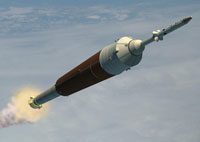NASA aims to end its dependence on Russia to bring US astronauts back to the Moon
Up to the year 2011, NASA is planning to purchase Russia’s Soyuz transports and Progress cargo freighters for crew trips and supply flights to the International Space Station (ISS). NASA will probably have to buy Russian-made spacecraft after 2011 too: the first manned flight of NASA’s new Crew Exploration Vehicle (CEV) should take place sometime between 2013 and 2015. In a bid to avert time dependence on Russia in terms of reliable and cost-effective access to the ISS, NASA launched its Commercial Orbital Transportation Services (COTS) Program.

In accordance with the program, NASA awarded a contract estimated at about $500 million to two U.S. aerospace companies, namely, Rocketplane-Kistler and Space Exploration Technologies (SpaceX) in August 2006. The companies will develop and demonstrate the vehicles, systems, and operations needed to support manned space missions and cargo flights to the ISS.
Rocketplane-Kistler is developing a fully-reusable orbital vehicle dubbed K-1. Meanwhile, SpaceX is developing Dragon crew and cargo capsules. All the above will use the “classic” scheme used for Soyuz and Apollo spacecraft i.e. launching into orbit by a booster rocket and re-entry by parachutes. As by the terms of the contract, the vehicles should carry out three successful space flights before 2010 and demonstrate the ability to deliver cargo to the ISS in pressurized and non-pressurized compartments alike. NASA does not rule out the possibility that the use of K-1 vehicle and Dragon capsules will prove to be more cost-effective than the use of the CEV. Once the capabilities of the COTS vehicles are successfully demonstrated, NASA will continue to use them for crew transportation and cargo delivery to the ISS even after the CEV enters service with NASA.
However, NASA will be using Russia’s Soyuz transports and Progress cargo ships if Rocketplane-Kistler’s K-1 Orbital Vehicle and SpaceX’s Dragon crew and cargo capsules fall short of the expectations. In his case, NASA will have to use Russian-made spacecraft through the second half of the 2020s. In the meantime, Japan, one of the participants of the ISS program, does not seem to have any doubts that Rocketplane-Kistler is capable of building a good and reliable space vehicle. In April 2007, Japan’s Manned Space Systems Corporation signed a memorandum of understanding with Rocketplane-Kistler on maintenance services to be rendered competitively to Kibo, the Japanese module scheduled to be integrated into the ISS in 2008.
In view of the forthcoming retirement of the Shuttle in 2010, NASA is apparently keen to invest in commercial space transportation services in the hope of solving the problems related to crew transportation and supply flights to the ISS. In a statement released February 2007, NASA said that it had signed agreements for the development of commercial transportation services with Transformational Space Corp. and PlanetSpace Inc. NASA signed similar agreements with Constellation Services International, SpaceDev, and Spacehab on June 18, 2007.
Again, NASA will probably have to cooperate with Russia to get the job done. For instance, Constellation Services International came up with a plan to deliver cargo to the ISS in a Russian cargo container on the tip of an American booster e.g. Atlas-5. The cargo container will “hang around” in orbit until the Russian unmanned automatic cargo freighter Progress takes care of it. The Progress cargo ship will be docked to the ISS. Once the cargo container is within reach, the Progress will dock off the station to snag it and bring it over to the ISS. The container will be then docked to the ISS and its cargo will be unloaded.
Nezavisimaya Gazeta
Translated by Guerman Grachev
Pravda.ru
Subscribe to Pravda.Ru Telegram channel, Facebook, RSS!

